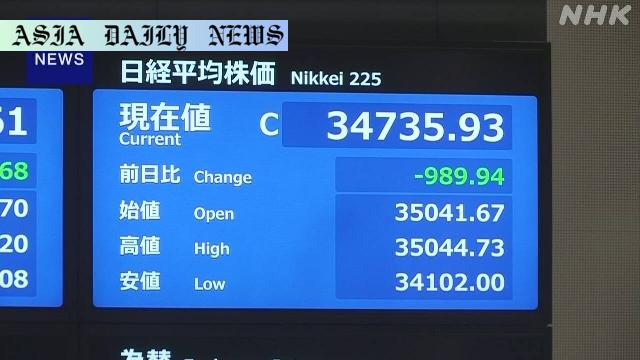Tariffs triggered a broad selloff in Nikkei 225, diving 2.8% as auto and yen-exchange markets faced significant pressures.
Key Point 1: Trump’s reciprocal tariffs caused a sharp decline in Asian markets, with Nikkei 225 plunging 4% intraday.
Key Point 2: The yen strengthened temporarily on currency markets, adding to investor concerns about trade war effects.
Key Point 3: Investors are wary of the global economic impact, with US long-term interest rates dropping as a result.

The Immediate Impact of Tariffs on the Nikkei 225
The announcement of a 24% reciprocal tariff by former President Donald Trump has caused significant ripples across global markets, particularly in Asia. On Thursday, Japan’s benchmark Nikkei 225 index saw a dramatic intraday plunge of 1,600 points, marking one of the steepest declines of the year. By the end of the trading day, the index had closed down 2.8% to reach 34,735—a striking reduction that pushed the benchmark below the 35,000 milestone for the first time in roughly eight months. The selloff seemed particularly concentrated in auto-related shares, demonstrating the vulnerability of Japan’s automobile sector to international trade policies. Analysts and market experts suggest that much of this reaction stems from fears of knock-on effects and the potential dampening of global economic activity as nations respond with counter-tariffs.
Currency and Investor Concerns
In addition to stock market challenges, the currency market also reacted sharply. The yen reached the upper 146 level against the US dollar in Tokyo’s foreign exchange markets. A strengthened yen has implications for Japan’s export-driven economy, further amplifying concerns over the Japanese economy’s outlook. These movements illustrate the ripple effects of the tariff announcement, as the strengthening of the yen likely reflected diminished confidence in dollar-denominated investments. Such fears extended beyond Japan to global markets, with notable declines in long-term US interest rates, driven by reduced attractiveness of dollar-based assets. Investors and financial analysts across the globe are now bracing for retaliation as other nations prepare measures against the US-imposed tariffs, potentially escalating global trade tensions.
The Global Context of Trade Wars
Trump’s decision to impose higher-than-expected tariffs is widely seen as a bold but risky move. Market sources suggest that the 24% rate significantly exceeded initial estimates, prompting widespread caution. The economic implications extend beyond just Japan or the US; they symbolize broader tensions within the interconnected trade networks of the modern global economy. Historically, trade wars introduce economic inefficiencies, disrupt supply chains, and stoke inflationary pressures worldwide. This latest development underscores the fragility of the current global economy, where decisions by major economic players carry consequences not only for their geopolitical rivals but also for aligned nations and business sectors reliant on robust international trade systems.
Broader Implications for Key Industries
Countries like Japan, with industries deeply exposed to export markets, could face longer-term challenges stemming from these tariffs. The automotive sector, already reeling from semiconductor supply shortages in recent years, is particularly vulnerable under such conditions. Major automakers and their supply chains depend heavily on predictable and low-friction trade to sustain profitability. This geopolitical development might force companies to re-evaluate global supply lines, production locations, and partnership strategies. In turn, we could see a shift away from current trade agreements toward regional or bilateral partnerships aimed at securing economic stability in turbulent times. Furthermore, smaller nations may find themselves in precarious positions, navigating between competing alliances in a trade war environment.
Investor Sentiment and Market Outlook
Market participants have expressed substantial apprehension over the cascading effects of policy-driven economic disruption. The Nikkei 225’s rapid decline serves as a stark reminder of how sensitive markets are to geopolitical announcements of this scale. Investors are understandably wary, adjusting their positions to mitigate risk and avoid exposure to industries most affected by the tariffs. However, opportunity often arises in times of uncertainty. With markets reacting sharply to this news, some investors could consider this a potential entry point, depending on how global trade relations evolve. Nevertheless, long-term resolution to current trade tensions will be essential to restore confidence in global economic growth prospects.



Commentary
The Bigger Picture: What Tariffs Mean for the Economy
The recent sharp decline in Japan’s Nikkei 225 index is a stark reminder of just how interconnected the world’s economies are today. While tariffs may be introduced as a strategy to protect domestic industries or rebalance perceived inequities in trade, the ramifications are seldom confined to one country. Trump’s imposition of 24% tariffs is a bold move, reflective of his administration’s prioritization of nationalist economic policies, but it also has tremendous collateral consequences. For an export-dependent economy like Japan’s, such trade barriers strike at the heart of industrial sectors like automotive manufacturing, which rely heavily on smooth international trade flows.
Ripple Effects Across Markets
One of the most interesting aspects of this situation is the strengthening of the yen and the corresponding weakening of the US dollar’s appeal. Such currency movements highlight just how fragile investor confidence is during times of geopolitical tension. The question of whether these tariffs mark the beginning of a prolonged trade war is a critical one, with the potential to destabilize not just manufacturing or financial sectors but the livelihoods of millions globally. Small businesses and economies reliant on stable international trade agreements stand to lose the most if tit-for-tat tariffs spiral out of control.
Navigating the Uncertainty
As markets react to this development, an important question arises: how can nations and businesses adapt to the rapidly shifting economic landscape? While some may see opportunities for growth within a more localized or protectionist framework, many others could face detrimental effects. Industries tied to exports may need to diversify markets—or explore innovative ways to circumvent costly tariff barriers. Central banks and financial regulators will also have their hands full, striving to maintain stability amidst unpredictable fluctuations in currency value and investor confidence. Ultimately, how policymakers and international stakeholders manage this situation will define the economic narrative for years to come.